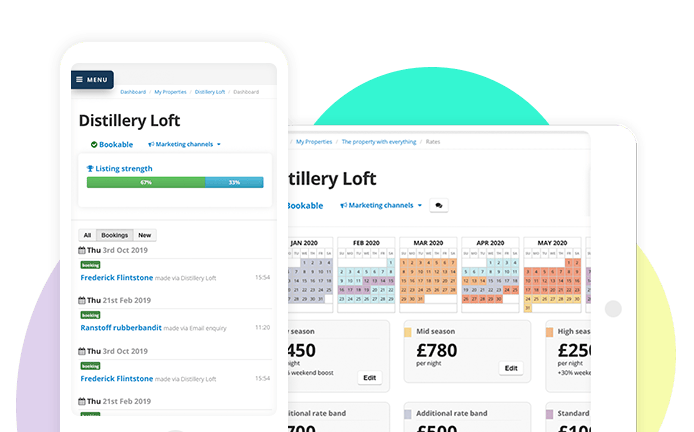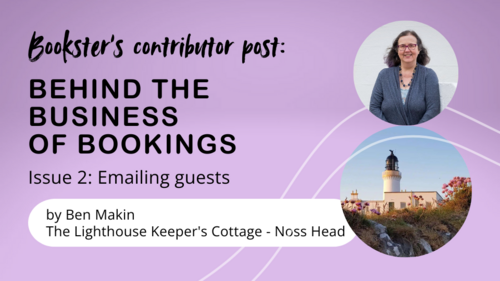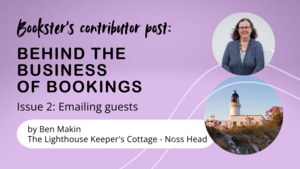Contributor post: How to send newsletters in holiday lets
3 minute read // updated
Key Takeaways
- Use email marketing to engage past and future guests and boost bookings.
- Personalise emails by writing to an ideal guest persona like 'Annie'.
- Keep newsletters engaging with short, visual content and clear calls to action.

Welcome to the second edition of our contributor posts, inviting holiday rental professionals to share their experiences of working in this diverse and interesting sector.

I started sending out emails using Bookster’s email marketing tool in 2023, and saw my bookings double with this and other marketing initiatives.
How to email guests about your holiday home
My name is Ben, I manage a holiday cottage in Caithness.
For ages I knew I should send out a newsletter, and I even captured email addresses on a feedback form. I had heard of different mailing systems, but GDPR put me off.
The game changer was realising I could use the email marketing tool in Bookster to comply with GDPR, design and send newsletters and automated emails, and to get email addresses off my website.
I won’t deny it took some work, but now sending a monthly newsletter is easy – and I have traced email sign-ups on my website to bookings a few months later.
Why email?
This isn’t spam!
Your email recipients know and like you. A lot of them have met you!
Your email may remind them of good times at your place, or it may be a prompt for a bucket-list stay in the future.
And we all need happy memories and things to look forward to right now. And of course, they are all potential future guests.
So this is a much warmer relationship than people who’ve liked your socials once, or seen a link to you on Google.
It shows in the response rates.
Don’t let this warm relationship go cold!
This blog post tells you how to write emails they’ll open, and won’t consider spam.
Who is your ideal guest?
Write a friendly note to your ideal guest. If you’ve not thought about your guest persona already, then think of the guest who loves your place the most – let’s call her Annie - and pretend you are sending an email privately to them.
Top tip: start your email with Hello [firstname,fallback=there!]. If you don’t have the recipient’s first name, it will say Hello there!
Writing your newsletter
Make the email about Annie, not the business. Say “Pour yourself a long cold drink, and watch the sun go down” not “there are great views from our garden”. Say “enjoy the bustle and buzz of the city on your doorstep” not “we are centrally located”.
For a general newsletter, have three or four topics, each one with a specific call to action in a button like “Check availability”, “Read my blog”, or “WhatsApp for info”.
Top tip: Use clickable WhatsApp links in your email and on your website – your enquiries will shoot up.
To make this manageable, I jot down three or four topics for my next month’s email, and write up one topic a week. I think short is sweet, with lots of photos, but always write it with your ideal guest in mind.
Topics - what will interest your ideal guest?
I limit myself to four topics at most, and always try to have at least two photos inside the Cottage, and one of the walks here, because that is what my ideal guests love best.
Topics might be:
- Anything new in the business – what’s good about this for Annie?
- Local events and things to do – why would Annie want to go?
- Link to your latest blog post – why would Annie want to read it?
- Promotions and giveaways – tell Annie she’s the first to know!
- Late availability
- A reminder about something Annie loves – that you are dog-friendly, or the
local nightlife’s great - A regular PS slot at the end: I share a seasonal photo of the area, but this is a great way to share your best reviews, or feature something guests love about staying with you – a photo of your “dog of the month” or “pub of the month” perhaps. Whatever Annie would love to see. And remember to put a call to action below it, taking them back to your website.
Using AI
We’ve all had emails written by AI. I don’t know about you, but I find that arrogant and off-putting, so I write my emails myself.
You can train AI to use your voice and write an email aimed at Annie. And of course, you can use AI for a first draft which you re-write, or to make your own writing crisper.
But I have to say that I am not a fan of AI myself, for lots of reasons.
A quick guide to the tech
Bookster’s email tool marketing offers lots of templates. The themes are very stylised, the layouts are much simpler. Choose one that reflects your business and – of course – that will appeal to Annie.
You can and should reuse the template, and you can customise it with colours from your website or logo.
Create each section with a headline and maybe an image, and put a button at the end of each section with a call to action.
Remember to put alt tags on each image to describe it for accessibility and for cautious people who choose “no images” in their emails.
Put links everywhere, not just in the buttons! The Email Overlay tool in the reporting suite show you which links your readers clicked on, and this is how I learned to add a link to every picture, as well as links dotted in the text.
Preview your email in mobile format as well as PC layout. And send a test. Read the test email once to make sure it will interest Annie, once to check for typos, and once again, checking alt tags and links.
Email Lists and GDPR
Bookster manages your email lists for you, and you can send emails to past and future guests - with the option to unsubscribe, of course. But you’ll want to get new people on your email lists.
- Create a new list for Website Subscribers inside Bookster’s email marketing tool.
- Use the tool to create a pop-up to capture people who visit your website. (It’s also worth creating a landing page to promote in your social media).
- Offer website visitors an incentive to sign up. Remember – this is about Annie having a great time, not you talking about your "news"!
- Use the promo code feature in Bookster’s Add Ons section to offer
- A discount – a fixed amount is easier to understand than a percentage.
- A free add-on – this could be firewood, or maybe some special
chocolates. Only offer something like Prosecco if you have an alcohol
licence. - A discount voucher for a local eatery – use a promo code for this, and give them a physical voucher when they arrive.
- Another option – called a “lead magnet” is a download. Create something that Annie would find helpful and store it as a PDF in Google Drive. Mine is a six page guide to my favourite hidden gems on the North Coast 500.
- Use the email automations tool to send out a reply whenever someone joins the list; this is where you send them the promo code or link to your lead magnet.
Steps for sending your first newsletter
- Go to Email Marketing in Bookster, select Campaigns, and Create a Campaign, and select the Design Email button and choose a template.
- Write your headlines and add your text, photos and call to action buttons.
- Check the links, and add Alt Text to describe the pictures.
- Preview and send a test.
- At this point I chose Back to checklist and fill in the details there, and then choose Prepare to Send.
How well did it work?
Explore the Insights section of the email marketing tool.
You can see results for every email that you send, who opened the most emails, and what calls to action have worked the best.
You can see who your most engaged readers are, and maybe select them for special offers. And there is a cool A/B testing feature to try out different headlines and different designs.
Ignore your stage fright - done is better than perfect!
Yes, triple-check for typos and that your links work, or get someone to do that for you. But ignore your stage-fright. I still get a buzz watching people open my emails in real-time, and seeing which links they’ve clicked.
My emails bring me repeat bookings, and they’ve reminded people about me, and turned them into guests months after their first visit to my website.
Resources and training
- Generic training - Business Gateway offer free training for businesses; choose their marketing and email courses.
- Specific training - There are some awesome people in the hospitality sector who are also trained in marketing. I have done training with Sarah Orchard and Jenn Boyles, and am also impressed by Lisa Roads and Yvonne Halling.
- Events - Direct Booking Success Summit
Frequently Asked Questions
- How often should you send an email?
- This is up to you – but regular is best, from fortnightly to once a quarter. Whatever you can commit to. Randomly spaced emails make you look scatty or desperate. I have committed to monthly emails, partly to reassure readers they won’t get needy spam. But if I had not said that, I could send out quick one-two emails announcing and reminding guests about a promotion, or short weekly updates in the season with late booking offers.
This is part of a series of contributor posts by holiday rental professionals, sharing experiences and expertise.
About Ben
My name is Ben, and I love welcoming guests to my holiday cottage at Noss Head Lighthouse in Caithness.
I started sending out emails using Bookster’s email marketing tool in 2023, and saw my bookings double with this and other marketing initiatives.
I see marketing as the best way to keep in touch with past, present and future guests.
These words are mine, and not written by AI. I have not been paid to write this: I am glad to have the chance to reach a new audience with my thoughts on running a holiday cottage as a business.
For more on my holiday cottage, check out my blog, or sign up for my newsletter.

